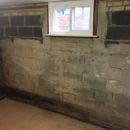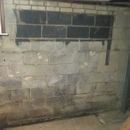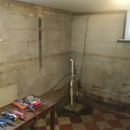Covering asbestos tile in basement
I live in a 1948 brick home with a basement. We are in the process of re-finishing half of the basement. Upon removing the carpet we discovered (likely) asbestos tile. It is not in good condition but mostly well-adhered. Consequently, we’d like to leave it and cover it. We are wondering the best way to do that. We are open to flooring options. On the walls, we are planning to insulate with rigid foam (Thanks for all the detailed responses on the forum. I have read, and learned a lot.) but we are stuck on what to do with the floor.
My thought was to insulate with 1″ foam on the floor, followed by 1/2″ ply wood (we live in DC, so this seems like an ok R-value?). However, the head space is low and every inch matters. So we are wondering if we can cover the asbestos with concrete leveler instead and avoid insulating the floor. From other forums, my gut tells me that we will have a temperature differential issue which could lead to higher humidity, particularly in the summer.
In the forums I haven’t seen guidance for insulating on top of tile. Am I missing something here? How would you finish the floor in our situation?
GBA Detail Library
A collection of one thousand construction details organized by climate and house part












Replies
Asbestos tile is fairly benign as the fibers are encased in plastic. Most cases you can remove it with minimal protection. I would take it out while you have the chance.
If you are not using the basement for much, the best is either loose lay or click vinyl. You can get vinyl with thicker backing which does make a big difference on comfort.
The other option is the insulated subfloor tiles, most box stores carry a style of it. Much easier to work with than foam+plywood as you don't need to screw it down. The stuff here is R3 around 1" thick and it works quite well. You can even paint the OSB if you don't care about the look as the finished floor.
If it helps, we'd like the space to be useful living space for guests and entertaining.
Get it tested before doing anything. It's 30 bucks: https://asbestostesting.com/ and they turn it around in a couple of days.
Note that it’s often the GLUE that has asbestos in it on old floors. Make sure to test the glue too. Even if it is asbestos-containing, it’s not hard to remove if you chip it off, just don’t grind it since that makes dust. Asbestos is dangerous to breath, but not to touch, so you need to take precautions against making dust — similar to what you’d do for cutting fiber cement with a saw.
I see no problem covering it all with floor leveler. If you can’t remove asbestos (“abatement”), the next best thing is to encapsulate it. As long as it’s not able to make any dust, you’re pretty safe.
Bill
At this point, I think it's safe to assume that we prefer covering the tile rather than remove it. That being said, what is the best method to go about doing this? We are trying to choose between encapsulating with a concrete leveler and then flooring, or another route (e.g. covering with foam insulation, plywood, and then flooring / some other product that accomplishes something similar like insulated subfloor tiles). We are aiming for the best solution without adding too much height and protecting against future mold growth. Thanks for the ideas and help.
OP, did you end up making a decision on this? I have this same exact problem with my basement, the only difference is the tile coverage is about 80% of the floor and it seems to be in very good condition (ie. "good enough to encapsulate"). I did rip up two rows of it so I could have my new stud walls adhere directly to the concrete sub-floor, but it was difficult remove them (wearing respirator, spraying lots of water and going slowly) so I don't want to remove the rest.
The only real information I can find about encapsulation is a "professional" solution using proprietary, multi-step flooring compounds... which seems overly complicated, expensive and maybe even impossible to purchase as a general consumer. I just worry that slapping down a layer of regular self-leveling concrete is a bad idea.
As long as the floor leveler adheres to the tile you should be ok. The purpose of encapsulation is keep the asbestos containing material from being disturbed and shedding any dust. Anything that blocks access to the material or binds it (like a glue) serves this purpose.
If you have trouble getting the floor leveler to adhere, I’d do a thorough cleaning of the tile and then prime it with an oil base primer (like coverstain). You could probably use something like Ames liquid rubber waterproofer as an encapsulant too instead of food leveler, although I’ve never tried that.
Bill
Ok great, thanks for the suggestions!